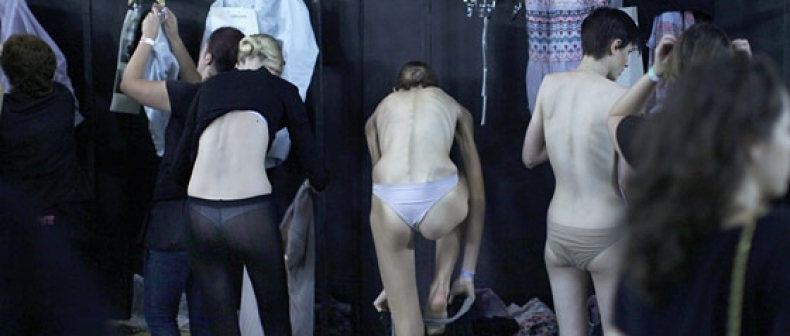
With all their long-legged wonder and thin-as-pins glory, it’s easy to forget that models are people too. For one thing, when they don’t eat enough, they die. Sometimes they’re teens who make bad choices and girls who deal with sexual harassment. They also like things like water and getting paid for their work. It’s a lack of basic workers’, and sometimes human rights that has spurred fashion councils around the world to act in defense of models.
In 2007, Montreal Fashion Week banned underweight models and those under the age of 16 from walking the runway. That same year, the Council of Fashion Designers of America (CFDA) released guidelines for models at New York Fashion Week (NYFW) that encouraged age minimums and healthy bodies. Since then, the CFDA has also received pledges from top modeling agencies – including DNA, Elite, Ford IMG, and Next — not to send any models younger than 16 to shows.
In March, Israel passed a law that prohibits fashion designers and media from using models that fall below the World Health Organization’s standard for malnutrition. London Fashion Week (LFW) designers sign a contract with the British Fashion Council (BFC) to use models who are at least 16, and the major fashion organizations in Spain and Italy also ban models who fall below a certain Body Mass Index level.
In Toronto? Crickets.
The FDCC’s website conspicuously lacks any mention of models, let alone guidelines that mention age, weight, or any other initiative to protect models. While media in other countries are quick to raise concerns over models’ rights, our media is remarkably silent. Is it simply because there isn’t a problem here? Or are we overlooking the issue thanks to good ol’ Canadian ‘that doesn’t happen here’ naïveté?
“In the past, change rooms were very exposed. So anybody could walk through and watch 15 or 16-year-old models ripping their shirts off between sets,” says Dan Grant, publisher of ModelResource.ca and an agent for Next Models. “There were people who were contracted to do maintenance stuff, but they were always walking through the change area between shows and often had their cell phones out. I’m positive that they were taking photos.”
Since Fashion Week’s move to David Pecaut Square, the FDCC now provides much more private change areas for models, but the tents are still (quite literally) a far cry from the land of milk and honey. “This year some of the designers brought food, but not all of them. There were still a lot of times when the models didn’t have anything to eat,” says Grant.
According to FDCC President Robin Kay, feeding models isn’t her job, “A couple seasons ago it came to my attention that the models weren’t getting fed. So in our designer handbook, it states clearly that the designers must feed the models.”
Except that message seems to get lost in translation to both designers and agents. “They didn’t give us any notice that they wouldn’t be providing food. I called the FDCC two days before the shows started to ask them if there would be food and they said ‘no, there’s nothing,’” says Grant.
“There was no food allowed period anywhere backstage. I don’t know who put that rule up… all I can say is that I think it’s ridiculous,” says designer Adrian Wu.
“Designers don’t often read their handbooks, do they?” quips Kay when I relay Wu’s statement to her. When the FDCC e-mails me a copy of the designer handbook, it does in fact say, in bold print, “Designers must supply food for models.”
The whole thing makes me think of The Hitchhiker’s Guide to the Galaxy when Earth is demolished in favour of a hyperspatial express route– the plans for which have been on display in “Alpha Centauri for fifty Earth years.” When humanity objects, the aliens boom back: “For heaven’s sake mankind, it’s only four light years away you know. I’m sorry, but if you can’t be bothered to take an interest in local affairs that’s your own lookout.” There just has to be a better, more obvious way to make sure the models get fed.
Toronto Fashion Week also lacks any sort of age guidelines. “We have a rule that a model is not supposed to be younger than – I think it’s in our book – I think it’s 16,” Kay tells me. We checked the handbook and couldn’t find anything of the sort (for the record, the handbook is four pages long with six lines devoted to models and casting). Grant has also never heard of any rules.
In fact, Grant thinks it’s good for underage models to gain experience in Toronto and claims Kay agrees with him. “We [the agencies] talked to Robin Kay about that in the past and she agrees with me. I actually have no problem with models under the age of 16 doing it in Toronto because it’s a very safe environment and I’d rather they learned it here before New York when they are 16.”
At least they’re raking in the dough, right? Not necessarily. Kay tells me the models are “absolutely” paid fair wages. “I had a top agent who operates the second largest modeling agency in North America be astounded at the good rates. So I thought that we were doing pretty well.”
“I really don’t think that they’re fairly compensated at all,” Grant begs to differ. “I think the rates start at about $175 for the very bottom-end shows and go from there. The models have to go to the casting, then to fittings and rehearsals, and then they have 3-hour call times before the show. When they finally get the $175 at the end of that 12-minute show, they’ve spent all these hours doing other things and have to give up 20 per cent of that to their agency.”
Grant singled out one designer who didn’t pay his models at all: “For most shows they’re paid, but there was one show… the Adrian Wu show (where they were not paid). Then, as far as I’m concerned, he degraded the models by putting masks on them.”
Wu confirmed that he didn’t compensate his models, but claims the experience still benefited them. “Many of them hadn’t done runway, so a lot of them were fresh faces. I personally trained each one of them because they had no runway experience. I spent over 12 hours with them to teach them to walk that way.”
As for Maskgate? “I guess it goes back to this awful question of are models people? Should people take the ideal of a model as what people should look like? I don’t believe that,” says Wu. “They’re mannequins to me; models are meant to look like mannequins. And if I choose to cover their faces, then I choose to cover their faces.”
As for models’ bodies, it’s up to agencies to decide if they’re too thin, which even Grant calls “unfortunate.” But he adds that Toronto clients aren’t interested in tiny girls, “They want a more athletic frame, so it’s not as much of an issue here as in other markets.”
“Canadians are big people; we have a lot of gorgeous girls from farms in the country. From my perspective, we’ve always had well-balanced girls on the runway,” agrees Kay.
Kay, in spite of the CFDA and BFC’s public positions, doesn’t feel it’s the FDCC’s place to take an official stance on the issue. “Over the years, I’ve been asked so many times to take a position on this, but it’s not my place… this is a democratic society, designers have to make their own choices.”
“As much as we are doing to promote Fashion Week at large, when it comes down to show-by-show and model-by-model, it’s between the designer and the agency,” she says.
So who’s feeding our models? It would appear that no one really knows.
____
Sabrina Maddeaux is Toronto Standard’s style editor. Follow her on Twitter at @sabrinamaddeaux.
For more, follow us on Twitter @TorontoStandard and subscribe to our newsletter.














